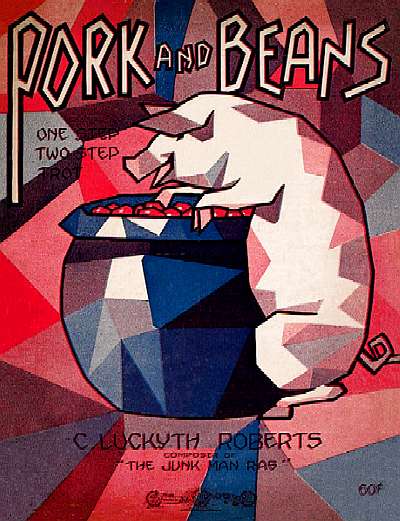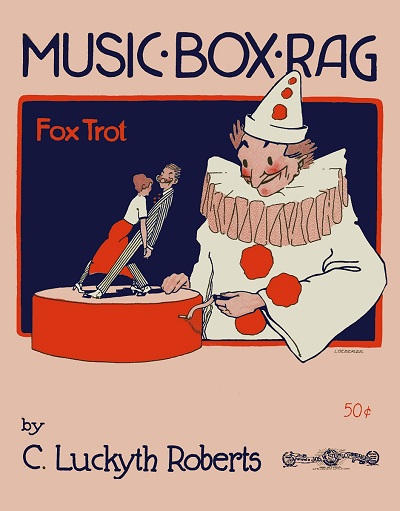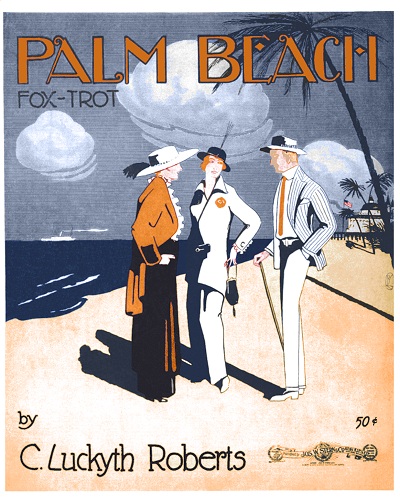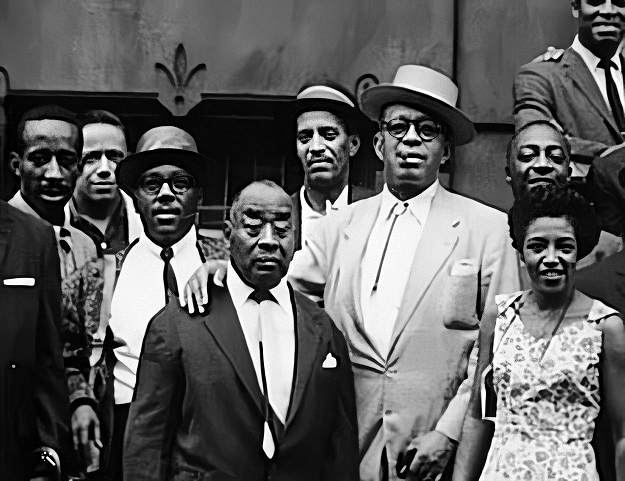 Charles Luckeyth "Luckey" Roberts (August 7, 1889? to February 5, 1968) | |
 Compositions Compositions | |
|
Unreliably Dated
Nothin' (c.1908)Shoo Fly (c.1910s) Ripples of the Nile (c.1912) 1913
Junk Man Rag (arr. Matthews)Junk Man Rag (arr. Tyers) Junk Man Rag Song [w/Chris Smith & Ferd Mierisch] Pork and Beans 1914
Music Box RagPalm Beach Tremelo Trot The Little Corporal 1915
Helter SkelterShy and Sly The Robin and the Red, Red Rose [1] Bon Ton: One Step Spanish Fandango (c.1915) 1917
Rockaway [1] [w/Howard Johnson]Billy Boy [w/Lester A. Walton] The Irresistible Blues 1919
Blue Fever1920
Railroad Blues [w/Haven Gillespie &Howard Washington] Spanish Venus (c.1920s) My Little Hush-a-bye Lady [1] (c.1920s) Baby Blues: Musical [1] Rock-a-bye Baby Blues Any Old Dance is a Wonderful Dance When You Dance with a Wonderful Girl Jewel of the Big Blue Nile Baby Blues 1922
Lonesome Longin' Blues1923
Leaping Leopards [1]Mamie [1] I Want a Good Baby Bad [w/Sam Lewis & Joe Young] [1] Go Go: Musical [1] New York Town Whipperwill Good Bye, Honey Falls Have You Any Little Thing Any Old Time at All I'm Scared of You Rosetime and You Happy Strutting the Blues Away Honey When You Dance With a Wonderful Girl Mo'lasses Indian Moon Uno Isabel Lolly-Papa Go Go Bug Pat Your Feet |
Sharlee: Musical [1]
Loving is a Habit Sharlee Little Drops of Water Princess Nicotine Heart Beats Cry Baby Love Today Broadway Rose Toodle Oo My Caveman - My Venus My Sunshine Love is the Bunk Honeymoon Row 1926
My Magnolia: Musical [1]At Your Service Baby Mine Shake Your Duster Pay Day Magnolia Hard Times Spend It Jazz Land Ball Laugh Your Blues Away Gallopin' Dominoes Headin' South Merry Christmas Struttin' Time Our Child Gee Chee Sundown Serenade Parade of the Christmas Dinner Baby Wants The Oof Dah Man Sweet Popopper c.1930s
Complainin'Porto Rico Maid 1936
I Wonder (If You Can Be Happy WithoutMe) [w/Louise B. Barratt] 1938
Teasin' Tessie Brown [2] [w/JimmyMundy] 1939
Whistlin' Pete1940
Moonlight Cocktail [w/Kim Gannon]1942
Massachusetts [2]Rainbow Land [2] Lost in the Midnight Blue [w/J.C. Johnson] 1949
Exclusively With YouPark Avenue Polka c.1950s
Outer SpaceInner Space
1. w/Alex Rogers
2. w/Andy Razaf |
 Rollography Rollography | |
|
1919
Railroad BluesIrresistible Blues Blue Fever 1923
Rosetime and YouMo'lasses |
Label/Number
[Vocalstyle 11356] 04/1919[Vocalstyle 11463] 09/1919 [Vocalstyle 11490] 12/1919 [QRS 2306] 08/1923 |
 Discography Discography | |
|
1916
Shoo FlyShy and Sly Shy and Sly (Retake) 1924
I'm Done [1]Bootlegger's Ball [1] 1927
Our Child [2]1946
Railroad BluesJunk Man Rag Pork and Beans Music Box Rag Ripples of the Nile Shy and Sly 1955
James P. Johnson/Luckey Roberts:Harlem Rent Party 1958
Luckey and the Lion - Harlem Piano1. accmp. for Alex Rogers/Eddie Hunter 2. accmp. for Charles Mack |
Matrix and Date
[Columbia unissued] 10/26/1916[Columbia unissued] 10/26/1916 [Columbia unissued] 12/27/1916 [Victor 29010] 11/17/1923 [Circle J-1026-B] 05/22/1946 [Circle J-1027-A] 05/22/1946 [Circle J-1027-B] 05/22/1946 [Circle J-1028-A] 05/22/1946 [Circle J-1028-B] 05/22/1946 (Same as the Circle sides) |
The birth date for Charles "Luckey" Roberts varies depending on source, including Roberts himself. While August 7 is mostly consistent (August 2 has been seen, but perhaps misread), his World War I Draft Card shows 1889, while his World War II Registration shows 1891, and some sources cite 1892. One passenger manifest shows 1894. A number of biographical sources show birth years as far back as 1887 and as late as 1895, a pretty wide variance. Either he was also not sure, or just changed the age to suit the situation. That he also seems to have sometimes evaded Federal census enumerators is another frustrating enigma, perhaps having used a different name, as deep searches have not found anything definitive. This was sometimes the case with traveling entertainers, as they were often not at home or traveling between places during the period when the enumerators tried to account for them. Robert's birth place of Philadelphia, Pennsylvania, is consistent in any case.
A small guy with a big heart and even bigger hands. That was Luckey Roberts. He was born to William L. Roberts, a self-trained veterinarian, and Elizabeth Williams, who tragically died just three weeks after her son's birth. His father, unable to handle the sudden burden, placed Charles with a Quaker show business family that he knew, the Ringolds, who were involved with vaudeville. His first stage appearances were with a troupe performing Uncle Tom's Cabin in which he simply slept onstage as a toddler. Later, his diminutive size helped to shape his original profession at the age of five, a tumbler on the vaudeville stage. This included a season with Gus Selke and his Pickaninnies, followed by a long stint with Mayme Remington and her Ethiopian Prodigies. With this troupe he learned acrobatic stunts from the team of Prevost, Rice & Prevost, which helped with his tumbling abilities, but also may have stunted his growth [this is unverified, but remains a possibility based on similar cases in history].
His father, unable to handle the sudden burden, placed Charles with a Quaker show business family that he knew, the Ringolds, who were involved with vaudeville. His first stage appearances were with a troupe performing Uncle Tom's Cabin in which he simply slept onstage as a toddler. Later, his diminutive size helped to shape his original profession at the age of five, a tumbler on the vaudeville stage. This included a season with Gus Selke and his Pickaninnies, followed by a long stint with Mayme Remington and her Ethiopian Prodigies. With this troupe he learned acrobatic stunts from the team of Prevost, Rice & Prevost, which helped with his tumbling abilities, but also may have stunted his growth [this is unverified, but remains a possibility based on similar cases in history].
 His father, unable to handle the sudden burden, placed Charles with a Quaker show business family that he knew, the Ringolds, who were involved with vaudeville. His first stage appearances were with a troupe performing Uncle Tom's Cabin in which he simply slept onstage as a toddler. Later, his diminutive size helped to shape his original profession at the age of five, a tumbler on the vaudeville stage. This included a season with Gus Selke and his Pickaninnies, followed by a long stint with Mayme Remington and her Ethiopian Prodigies. With this troupe he learned acrobatic stunts from the team of Prevost, Rice & Prevost, which helped with his tumbling abilities, but also may have stunted his growth [this is unverified, but remains a possibility based on similar cases in history].
His father, unable to handle the sudden burden, placed Charles with a Quaker show business family that he knew, the Ringolds, who were involved with vaudeville. His first stage appearances were with a troupe performing Uncle Tom's Cabin in which he simply slept onstage as a toddler. Later, his diminutive size helped to shape his original profession at the age of five, a tumbler on the vaudeville stage. This included a season with Gus Selke and his Pickaninnies, followed by a long stint with Mayme Remington and her Ethiopian Prodigies. With this troupe he learned acrobatic stunts from the team of Prevost, Rice & Prevost, which helped with his tumbling abilities, but also may have stunted his growth [this is unverified, but remains a possibility based on similar cases in history].Charles' father was still involved in his life and visited often when he was close enough to do so. During his time with Mayme it appears that Roberts discovered and took to the piano right away, and his father helped encourage this by getting professional lessons for his young son. Fairly soon he became an all-around showman. Charles never made it beyond 4'10", but his hands could reportedly reach something just short of two octaves, one octave and a fifth at the very least. He also had a very strong physique, perhaps over-proportionate to his size. Having been born a Pennsylvania Quaker, he abstained from alcohol throughout his life, a rather amazing feat when you consider where he played and that he owned a popular bar in his adopted Harlem home.
In 1911, having established himself firmly playing up through Atlantic City and now Manhattan, Luckey got a job as a musical director with producers Homer Tutt and Salem Tutt Whitney in their Southern Smart Set Company, an off-Broadway troupe. It was here that he met Lena Sanford, a professionally trained operatic singer, who he would eventually be married to for over 40 years. Lena appears on his 1917 draft record as his contact. Roberts would ultimately remain as musical director of the Smart Set until 1919 in addition to his other work.
Lena appears on his 1917 draft record as his contact. Roberts would ultimately remain as musical director of the Smart Set until 1919 in addition to his other work.
 Lena appears on his 1917 draft record as his contact. Roberts would ultimately remain as musical director of the Smart Set until 1919 in addition to his other work.
Lena appears on his 1917 draft record as his contact. Roberts would ultimately remain as musical director of the Smart Set until 1919 in addition to his other work.Charles was the first of the Harlem school of pianist/composers to get published as well. He met composer/arranger Artie Matthews in Cincinnati, Ohio [or possibly St. Louis, Missouri] around 1912, and Matthews arranged Luckey's Junk Man Rag for publication. Matthews' arrangement was toned down from Roberts' dynamic performance style, and played at a moderate tempo it resembled a Scott Joplin-styled rag. Ultimately, it was a looser arrangement of the same piece by Will Tyers that saw wide distribution, and that work led to publication of other great compositions like Music Box Rag and the dynamic Pork and Beans.
Many of the pieces Luckey allegedly composed during the 1910s did not appear in print, but were recorded in the 1940s and 1950s. Some were simply too complex to notate given their range and subtleties. Just the same, he was the earliest of the Harlem stride pianists to record as well, cutting a number of sides in 1916 for both Victor and Columbia Records, which were ultimately unissued for varying reasons. According to a Columbia memo, the pieces were "unsuitable to artist," which more likely had to the with the difficulty of recording piano played in this style with acoustic horns than it did with the artist playing his own compositions. Also in the mid teens, Roberts became an inspiration and sort of a mentor to a young boy who wanted to learn jazz, even before it had a name, and closely studied the master's playing. There would be a time in the near future that the boy would pick up many of those moves and make a name for himself as George Gershwin. Some of Gershwin's performance attributes and tricks were originally learned from Roberts, and then applied in new ways.
Ultimately, Luckey Roberts ended up as a life-long performer. He befriended most of the best pianists that frequented New York, including life-long friends Eubie Blake and Willie "The Lion" Smith plus many charter members of James Reese Europe's Clef Club. With that organization Luckey was an occasional performer for the famous dancing team of Vernon and Irene Castle. He was part of Europe's famed 369th Infantry "Hellfighters" platoon and band during World War One, who collectively took France by storm both in a military and musical capacity. Many members of that unit found they preferred life France as they found little racial bias there, and a great deal of enthusiasm and respect for their music. While some either stayed behind or returned within a couple of years, Luckey went back to the United States in 1919 to resume his music career.
While some either stayed behind or returned within a couple of years, Luckey went back to the United States in 1919 to resume his music career.
 While some either stayed behind or returned within a couple of years, Luckey went back to the United States in 1919 to resume his music career.
While some either stayed behind or returned within a couple of years, Luckey went back to the United States in 1919 to resume his music career.Once back Roberts started out with a small band consisting of himself, a mandolinist, saxophonist and drummer. He quickly worked his way up to his own society orchestra that became quite the rage. They regularly played parties for the elite 400 (the most influential 400 families) in New York, Rhode Island, and Palm Beach in Florida, the latter about which he penned one of his early stride pieces. His orchestra work kept him well occupied throughout the 1920s and 1930s. Luckey also worked as a Broadway composer from time to time. In 1920 Roberts and his frequent collaborator Alex Rogers formed their own publishing company, Rogers & Roberts at 386 Cumberland Street in Brooklyn, releasing songs from their recent but short-lived musical comedy Baby Blues. One of the pieces was dedicated to popular stage singer Nora Bayes who may have performed it as well.
Rogers and Roberts also contributed most of the songs to the Broadway musical Go Go which ran for a fair 138 performances both in Manhattan and in Harlem, though it was not a huge success. Go Go was described in the trade papers as a sort of white Shuffle Along, referring to the Sissle and Blake musical that had been a big hit. They followed this that same year with Sharlee which ran only one month. This show was followed by a 1924 vaudeville tour of Luckey Roberts and His 12 Browns, "a whirlwind array of the the speediest entertainers in vaudeville." Another attempt at Broadway was made by Roberts and Rogers and a producer in 1926 with My Magnolia, a "colored musical" which only made it through four performances at the Mansfield Theater in front of fickle New Yorkers. Lena was listed in the cast of the production. It would not be Robert's last attempt at musical stage pieces, however. During the early-to-mid-1920s Luckey had also appeared sporadically on the radio, with some live spots on the popular music station WDT in Manhattan. This would be followed by some stints on deluxe cruise ships to Europe and back.
Along with his friend and fellow musician James P. Johnson, Roberts was one of the early progenitors of what became known as Harlem stride piano. The reach of his hands certainly helped enable this, but given his size it also help to perpetuate a rumor for many years (unfounded and unlikely) that he had the webbing of his hands surgically altered to enable that reach. Fats Waller, Eubie Blake and Johnson who all had similar reaches should help disprove this story. His prowess with stride piano was centered more in his playing than in composing, like his counterparts. Many of his contemporaries marveled not only at his reach but his great strength and control over subtleties as well. He could break down a piano in short order with his hard an percussive style, but if he liked the tone of a particular instrument he could caress wonderful tunes out of it as well.
Among other admirers and protégés were Duke Ellington, "Fatha" Earl Hines and singer Ethel Waters. Another was a true member of royalty that he had met while entertaining the "400" years before. As published widely in newspapers in late June 1937, "Luckey Roberts, famous purveyor of music to the '400', received a cablegram from the Duke of Windsor last week. Mr. Roberts, who knew the Duke well, when he was Prince of Wales and was invariably selected to play for the parties where the Prince was entertained during his last visit to America, had cabled congratulations to the Duke and Duchess on the occasion of their wedding. The Duke cabled his appreciation of Mr. Robert's message. Luckey announced that he was sending the Duke and Duchess a group of phonograph records, one for each month of the year." This was actually a fairly generous gift at that time, but whether they were Roberts' own recordings is unclear.
Another typical but very notable example of Luckey's pull and his reputation was reported on virtually the same day as the story on the Duke of Windsor: "Luckey Roberts and his band, society entertainers, have been selected by Mrs. J. A. Montgomery, aunt of Miss Ethel Du Pont, fiancée of Franklin D. Roosevelt Jr. [the current president's son], to play at one of the most important of the pre-nuptial parties to be given in honor of the young couple. The event, to be held in Wilmington, Delaware, Monday evening, is to be an exclusive affair with only 60 guests from all over the country in attendance.
It is reported that Eddie Duchin, Vincent Lopez and a number of other society orchestras angled for the assignment, but that Mrs. Montgomery made the selection of Roberts' band at the suggestion of Miss Du Pont and Mr. Roosevelt." This was a high honor for any performing group. Roberts joined ASCAP in 1939, the year of its Silver Jubilee.
 |
The veteran entertainer gained new notoriety in the 1940s with his Harlem night spot, Luckey's Rendezvous at 773 St. Nicholas Avenue, which featured him and his friends, and always had good entertainment. Guests were often served by a singing wait staff. There were major performances with his 55-piece International Symphonic-Syncopated Orchestra at Carnegie Hall on August 30, 1939 which included his Spanish Suite, and in 1941 in Town Hall in Manhattan. Roberts even had a minor radio hit with Moonlight Cocktail, a derivative song from his Ripples of the Nile, which was recorded a few times over the next decade including a signature track by bandleader Glenn Miller. Luckey's song Massachusetts also made it to the hit parade in 1942.
Although his restaurant, The Rendezvous, was in Harlem, as of the 1940 census Charles and Lena were living in Queens with Lena's remarried and now widowed mother Mary Hawkins, with Luckey still claiming to be an orchestra musician, even though such engagements were quite rare for him by the forties. By 1950 the Roberts were living in West Harlem on Convent Avenue, with Charles as the proprietor of his restaurant and bar, indicated in the census. Also in the household was a granddaughter, her husband, and a great granddaughter just a few months old. During his time in Harlem, Roberts survived muggings and robberies in his restaurant, a series of small strokes, and two major car accidents, one of which shattered his talented hands. But he fully recovered, and only partially retired after closing the Rendezvous in 1954. His friends noted that Roberts was simply too generous in handing out drinks to his friends, and wasn't able to meet expenses in the end, but this runs counter to the truth of his fairly solid financial standing. In 1958 Roberts made a fabulous stereophonic recording for the Good Time Jazz label. This session, along with a set of sides recorded for Circle Records in the mid-1940s, are among the best surviving echoes of the era of Ragtime and Stride piano.
Roberts was also present with his friend Willie "The Lion" Smith for the August 1958 photo by Art Kane, "A Great Day In Harlem," published in Esquire magazine, although Smith was tired of standing and hiding from the heat when the official photo was finally taken. Luckey was the oldest musician in the photograph. The photo itself was used as a basis for the film The Terminal, in which a foreign visitor came to the United States to collect the final autograph of all those in the photograph, which would assumedly have already included Roberts.
In spite of his age, Luckey refused to fully retire, even though there were reports of poor health that kept him from performing in public as early as 1960. He even attempted two last musicals, Emalina and Old Golden Brown, the latter a sort of musical autobiography. Even after a decade of tweaking of the music and the plot lines, neither were ultimately produced. However, one of his final tunes, Exclusively with You, has had some performances since. When Roberts died while staying at the Mayflower Nursing Home in 1968, he was in very good financial shape, having made over two million dollars in astute real estate deals over the decades, and running his music and nightclub businesses very effectively.